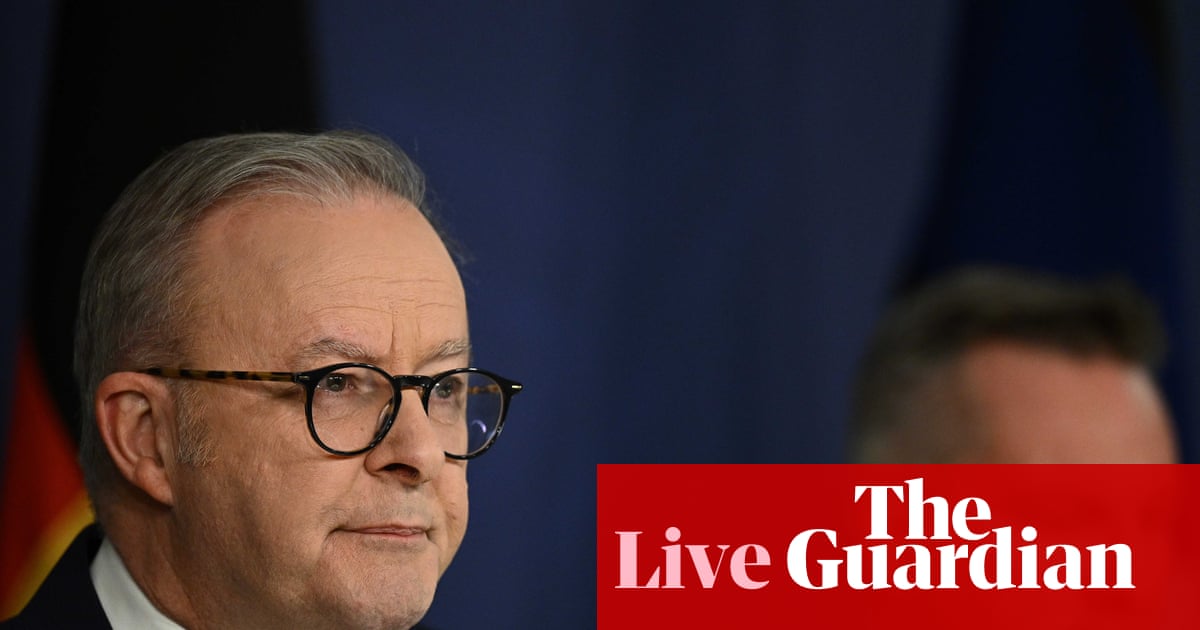The global shift to clean energy is the “biggest economic transition since the Industrial Revolution” says the climate change and energy minister, Chris Bowen, who takes the mic after Albanese.
Bowen says the advice from the Climate Change Authority was to help determine an “achievable and ambitious” target, and one that can be done in “a realistic fashion”.
Bowen says the target comes with a comprehensive plan on how to get there.
The updated plan that we are releasing today is that path together with the six sector plans that we release today that show industry and investors what the government thinks is the most feasible decarbonisation pathway beyond 2030.
There’s a few commitments under the target that are being announced today:
$2bn for the Clean Energy Finance Corporation.
A $5bn net zero fund within the national reconstruction fund.
$1.1bn for the production of clean fuels – announced yesterday.
$40m to speed up the rollout of kerbside and fast EV charging.
$85m for frameworks to help households and businesses improve their energy performance.
$50m for sports clubs to decarbonise.
Updated at 22.25 EDT
Key events
Please turn on JavaScript to use this feature
Emissions reduction target ‘a denial of climate justice’, 350.org says
350.org, a major international climate change group, said the targets announced today were “nowhere near what is needed to secure our survival”.
Fenton Lutunatabua, the group’s deputy head of regions, said in a statement:
Anything less than a 75% cut this decade backed by a plan to phase out coal, oil and gas is not a climate plan, it’s a denial of climate justice.
Pacific peoples are already living the losses that come from every fraction of a degree of warming. The supposed ‘sweet spot’ decided by the Albanese government is nowhere near what is needed to secure our survival. Not only that, but it doesn’t address the enormous burden of Australia’s fossil fuel exports, the consequences of which the children of the Pacific will have to bear.
Anthony Albanese. Photograph: Mick Tsikas/AAPShare

Sarah Basford Canales
Brittany Higgins to appeal damages after defamation ruling
Brittany Higgins will appeal a $341k payout and 80% of legal costs to her former boss, ex-Liberal senator Linda Reynolds, after a Western Australian supreme court ruled last month she defamed the once-Liberal frontbencher in two social media posts.
Two appeal notices, submitted to the court on Wednesday, show Higgins’ defence team will fight the orders delivered by Justice Paul Tottle on 27 August.
Tottle ruled Reynolds’ reputation was damaged by a 2022 social media post from Higgins’ partner David Sharaz, which Higgins responded to, as well as an Instagram story published by Higgins in July 2023.
Higgins’ legal team, however, successfully defended a third social media post – also found to be defamatory – as honest opinion, fair comment and qualified privilege. Reynolds was unable to prove Higgins and Sharaz had concocted a conspiracy to publicly release the details of Higgins’s alleged rape with the “sole or predominant purpose” of destroying the former senator’s reputation, Tottle’s judgment said.
The court ruled that Higgins pay $315,000 in damages with an additional $26,109.25 in interest. Earlier this month, the court made a separate ruling on additional costs, ordering Higgins to pay 80% of Reynolds’ legal costs for the five-week defamation trial. It’s expected the total bill will easily surpass million-dollar territory.
The appeal notices show Higgins’ legal team is not appealing the judgment but focusing on the damages payout and the direction to pay 80% of Reynolds’ legal bills.
Updated at 23.29 EDT

Krishani Dhanji
Well that was a highly anticipated announcement, and there’ll be plenty more reaction to it throughout the day! I’ll hand you back over to the wonderful Nick Visser to bring you all that.
ShareAnalysis: Labor’s climate targets promise everyone a prize

Adam Morton
The Albanese government has announced an Oprah Winfrey-style emissions target for 2035 – tried to promise (nearly) everyone a prize.
We haven’t had time to absorb the advice that underpins it, but the range of 62% to 70% is clearly at least partly a political solution. It is extraordinarily wide.
At the bottom end, the goal is clearly designed to dampen criticism from business organisations arguing for less action. At the top end it meets a demand from some scientists and climate campaigners that it must include a number with a “7” in front of it – that is, that it reaches into the 70s.
This won’t be enough to nullify criticism: it is already pouring into my inbox from climate-focused organisations and scientists. The reality is the target sets a minimum goal of 62% but scientists say the country’s part in meeting the goals of the 2015 Paris agreement would be more than 75% – possibly significantly more.
The range is well below what the Climate Change Authority thought was “ambitious, but achievable” early last year when it nominated 65% to 75%. Why the change? We need more detailed answers on that than we got at the press conference.
Will this goal help Australia take a leading role in avoiding the worst projections set out in the national risk assessment released on Monday? Certainly not if we end up at 62%.
But what matters now is the policies. And we will need a lot more – a lot more – to get where we need to be.
Updated at 23.30 EDT
Fortescue head says Labor has shown ‘courage of leadership’ but calls for even higher emissions cuts
Andrew Forrest, chairman of mining giant Fortescue, has also called on the government to be more ambition, arguing the upper range of 70% should be a “floor” not a ceiling.
It [the government] has shown the courage of leadership. Yet let me be clear: the upper range of its target – 70% – must be a floor, not a ceiling.
A cut of at least 75% is what is needed for Australia to pursue emissions reductions in line with the science. This remains the only course that can avert the accelerating impacts of a world warmed beyond 1.5°C.
Fortescue was one of more than 500 businesses including Atlassian, Canva, and Unilever calling for a 75% target in the lead up to the announcement.
Andrew ‘Twiggy’ Forrest in 2023. Photograph: Lukas Coch/AAP
Former emergency leaders are also warning the target will leave emergency responders in a critical situation. The Emergency Leaders for Climate Action group warns the bottom end of the target will fall “dangerously short of what’s needed to protect both communities and emergency responders.” The former commissioner of Fire & Rescue NSW, Greg Mullins, says:
If that’s the level of risk we’re accepting, then what’s the plan for dealing with it? Emergency leaders want to see a concrete, well-funded plan for how the Albanese government is going to support communities and first responders to adapt to the compounding, cascading and concurrent disasters its own risk assessment outlines if we’re choosing not to cut climate pollution any further or faster.
Updated at 23.20 EDT
Environmental groups’ verdict on Labor emissions targets: ‘weak’
We’re getting plenty of reaction to the 2035 target, and environment groups are pushing for far more ambitious action.
Greenpeace has called the target “weak” while the Australian Conservation Foundation has labelled it “timid”.
Both groups accuse the government of prioritising the fossil fuel industry over community safety.
Greenpeace Australia Pacific says the target is “not science-aligned, and undermines global action under the Paris Agreement to limit warming to 1.5C”.
It prioritises fossil fuel profits and business interests over people, and effectively abandons our commitment under the Paris Agreement… a temperature goal that is non-negotiable for Pacific nations staring down the barrel of climate catastrophe.
The ACF’s climate and energy program manager, Gavan McFadzean, says:
A target range of 62% to 70% falls significantly short on all measures of what’s needed, with the government’s plans preparing Australia only to meet the bottom end of the range.
Updated at 23.10 EDT
PM won’t say how much power bills will drop under 2035 plan
The prime minister says there needs to be “lean in” from all levels of government and business to get to the target.
He also adds that the amount of wind and solar power in China is now “nearly twice as much as the rest of the world combined. Just a fun fact”:
We have a target range, it depends upon as we have outlined, whether there is a lean in and by other levels of government, by the private sector as well, industry … we know that the federal government can only do so much.
Finally, Albanese is asked exactly how much power bills will come down (which makes all the journalists in the room laugh).
Anthony Albanese and Chris Bowen (back) announcing the 2035 climate emissions targets. Photograph: Dan Himbrechts/AAP
Albanese won’t give a figure – you might remember how much the opposition likes to bring up Labor’s pre-2022 election promise of a reduction in energy bills by $275, which they had to abandon. The PM says:
You yourself laughed when he asked that question so, it should be treated in the spirit which you’ve done. What we know is if we do not act, they will be a cost [to] the economy as [the] treasurer has outlined. They will be: lower wages, lower growth, less jobs.
Updated at 23.23 EDT
Bowen says target ‘within the realm’ of global emissions reduction to keep warming under 1.5 degrees
Further to the last point, Bowen says the work by the Intergovernmental Panel on Climate Change shows that Australia’s target is within the realm of keeping global warming under 1.5 degrees.
We will not pretend that some sort of figure over 70[%] with no evidence or no modelling or no advice is achievable [or] is a sensible ambition for this country to go after. The IPCC, in their report about what was necessary, said 68% [is] around the world emissions reduction. That is within our range.
On how the government will get there, Jim Chalmers adds that the target and modelling released today will help investors “invest with confidence” to achieve the target.
Private investment will be the thing that help us achieve this ambitious target and get us closer to the 70% and the 62% … and so our priority, recognising our constraint, is to leverage as much private investment as we can.
Updated at 22.58 EDT
Bowen confirms target aligns with goal to limit global warming to 1.5 degrees
Albanese is asked whether the range means the government’s target is actually 62%.
He says the target is consistent with those of other nations who also have a target range, and says it’s consistent with technological development that will help Australia achieve that target range.
The government is also asked whether the range means the government isn’t aligned with the goal to limit global warming to 1.5 degrees.
But Bowen says the target still has that objective.
It is very clear that we have set a target based on science and the objective of 1.5 degrees. That is what we are required to do under law.
They [the Climate Council Authority] said we should go for maximum ambition. They then looked at what is achievable in the Australian context and that is exactly 62% to 70%.
This range reflects two things, it reflects that technology changes over a decade in ways that not everyone can easily predict 10 years out and we recognise that.
Bowen was also asked about whether there will need to be changes to the Safeguard Mechanism and New Vehicle Efficiency Standard – he says both are subject to legislative reviews next year.
Updated at 22.58 EDT
‘We think we have a sweet spot’: PM
Anthony Albanese says the independent advice from the Climate Change Authority is based on science but is also consistent with the European Union’s target.
This is ambitious but achievable.
We think we have a sweet spot that will be criticism from some who say it is too high some who will say it is too low. What we have done is accept the Climate Change Authority’s advice and, importantly, this is worlds best practice.
The Climate Change Authority chair, Matt Kean, says the targets are about opportunity and delivering a “cleaner and safer and better” world for future generations.
He says the CCA considered more than 500 submissions and conducted over 560 meetings and events to reach the target range.
There is a path that will deliver benefits and savings, not cost. Our leading scientific body, the CSIRO has done that work. This is a range that I am hopeful we can overachieve on. Our range positions Australia is a global leader on climate.
Today’s report is ambitious for Australia, ambitious for a prosperous future.
Updated at 22.58 EDT
Treasurer: net zero transition ‘golden opportunity’
The treasurer, Jim Chalmers, says he asked his department to model several scenarios, which found a “disorderly transition” would result in lower wages and higher electricity prices.
But a 65% target, which is what Treasury modelled for the government – broadly in line with what the Climate Change Authority would recommend, Chalmers says the department found the economy would be better off.
The baseline scenario would see our economy $2.2tn bigger by 2050 and an extra $36,000 per person wealthier 5.1 million jobs and investment up 80%. That is the baseline scenario that represents the trajectory that the government believes is the baseline coming from the arrangements that we are announcing today.
If we leave the heavy lifting to others at the start of the 2040s and where our country and economy would need to scramble to hit net zero by 2050 and in the disorderly transition the economy would be a cumulatively $1.2tn smaller.
Chalmers also adds that he welcomes the unemployment rate remaining at 4.2%, and says the labour market has been a “genuine source of strength”. On the immigration rate he says:
We are now 17,000 people lower than the Treasury forecast for net overseas migration and 40% below the peak that we saw in that overseas migration following Covid.
Updated at 22.23 EDT
Bowen outlines commitments for ‘achievable and ambitious’ target
The global shift to clean energy is the “biggest economic transition since the Industrial Revolution” says the climate change and energy minister, Chris Bowen, who takes the mic after Albanese.
Bowen says the advice from the Climate Change Authority was to help determine an “achievable and ambitious” target, and one that can be done in “a realistic fashion”.
Bowen says the target comes with a comprehensive plan on how to get there.
The updated plan that we are releasing today is that path together with the six sector plans that we release today that show industry and investors what the government thinks is the most feasible decarbonisation pathway beyond 2030.
There’s a few commitments under the target that are being announced today:
$2bn for the Clean Energy Finance Corporation.
A $5bn net zero fund within the national reconstruction fund.
$1.1bn for the production of clean fuels – announced yesterday.
$40m to speed up the rollout of kerbside and fast EV charging.
$85m for frameworks to help households and businesses improve their energy performance.
$50m for sports clubs to decarbonise.
Updated at 22.25 EDT
Renewables backed by gas and battery storage, says PM
Albanese says emissions need to drop in electricity, transport and industry, and announces $2m for the clean energy finance corporation, to “accelerate long term renewable projects”.
There’s also $40m on the table to accelerate the rollout of curb-side fast EV charging.
He also takes a swipe at the opposition for their “23 different energy policies and did not land one of them”.
Today we announce a fund in the national reconstruction fund to help large industry decarbonise and scale up more renewables and low emissions manufacturing. This builds on what we have been doing through the safeguard mechanism.
[Renewable] capacity is up 45% since we came into government, enough to power some 6m households.
Updated at 22.23 EDT
Labor announces 62-70% emissions reduction target
Labor has announced it will set a 62-70% emissions reduction target by 2035, taking the advice of the Climate Change Authority and says it’s the “right target”.
Anthony Albanese is standing up with the energy minister, Chris Bowen, the treasurer, Jim Chalmers, and Climate Change Authority chair, Matt Kean, in Sydney.
This has been a highly anticipated announcement, and comes just ahead of the PM taking off to New York this week for the United Nations General Assembly, where he will submit the target.
Albanese says:
This is a responsible target supported by science and a practical plan to get there and built on proven technology. It is the right target to protect our environment, to protect and advance our economy and jobs and to ensure that we act in our national interest and in the interest of this and future generations.
Updated at 22.10 EDT

Patrick Commins
Jobless rate steady at 4.2% despite fall in employment
The unemployment rate stayed at 4.2% in August, despite the number of employed people falling by 5,000 people in the month.
The latest figures from the Australian Bureau of Statistics showed a 41,000 drop in full-time employment, partially offset by a 36,000 rise in part-time jobs.
The steady jobless rate was expected, although economists had forecast employment growth of 21,000, so the jobs report is broadly a disappointing one.
A slight drop in the workforce participation rate – essentially the pool of people either working or actively looking for work – helped explain the unchanged jobless rate, despite a drop in employment.
The key unemployment measure has been bumping around in the low 4s since early 2024.
Updated at 21.56 EDT
Krishani Dhanji is going to take the reins ahead of the big climate announcement.

Dan Jervis-Bardy
Labor to set 62-70% climate target
Australia will aim to cut greenhouse gas emissions between 62% and 70% on 2005 levels by 2035 under the Albanese government’s new climate target, a Labor source told Guardian Australia.
The prime minister is due to unveil the target at 12pm in Sydney after cabinet met on Thursday morning to consider the Climate Change Authority’s advice.
The authority’s preliminary advice suggested a target of between 65% and 75% was ambitious but achievable.
Updated at 22.06 EDT
